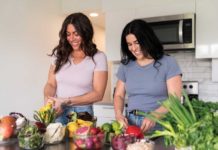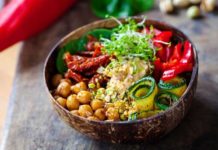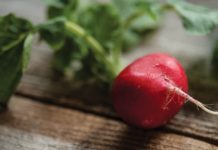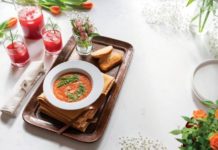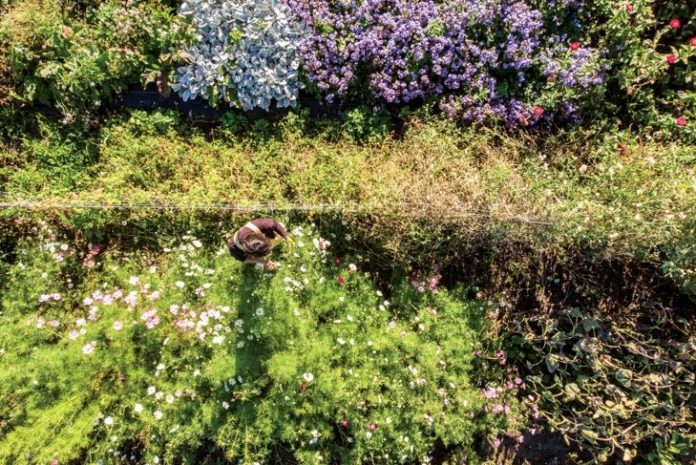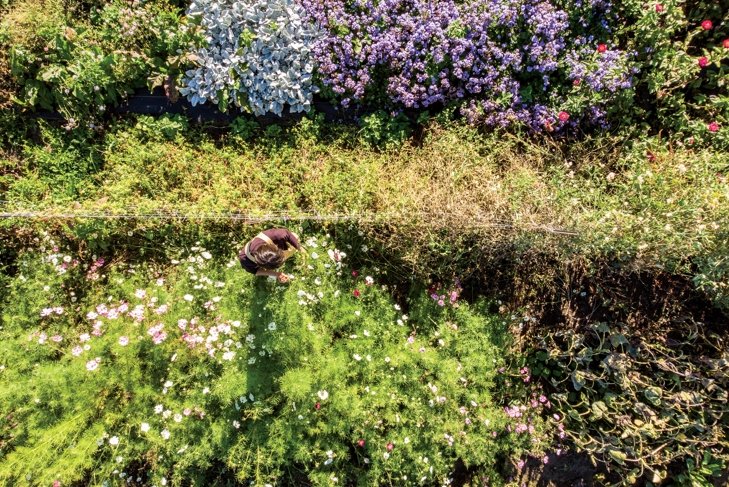
Many of us conscientiously seek out organic food products—but what about that bouquet of flowers we add to the grocery basket on a whim? Flowers bring good things to our lives; making sure they’re organically farmed helps spread the goodness.
“What’s in a name? That which we call a rose / By any other word would smell as sweet,” Shakespeare’s Juliet famously asserts in the throes of star-crossed love. A fair point. But what if the names of our Valentine roses and other cut flowers happen to include the (admittedly unromantic) term “certified organic”? Should that make a difference?
Emphatically organic
For Rachel Ryall of River and Sea Organic Cut Flowers, a family farm in Ladner, BC, the answer is an emphatic yes. Although public awareness of organic flowers lags behind our understanding and appreciation of the benefits of organic food, Ryall is deeply committed to fostering those benefits in her practice.
We need to understand, she argues, that organic farming involves more than just the food we eat and its effects on our bodies. Whatever is being cultivated—apples or asters, zucchini or zinnias—farming methods have widespread effects on our ecosystems.
Avoiding toxic blooms
Unlike the plants they’re meant to preserve, flower-industry pesticides and their effects are neither beautiful nor ephemeral. A recent Belgian study of pesticide residues in common cut flowers detected an average of 10 contaminants per sample bouquet.
Roses were the most severely contaminated, averaging 14 “active substances”—several of them toxic—per sample. The fungicide dodemorph, the most frequently detected and highly concentrated substance found in the Belgian study, comes with a long list of acute and long-term hazards, both to human health and the health of aquatic ecosystems.
Romantic? Hardly. Necessary? Not at all.
Beauty and bounty— without pesticides
Ryall’s magnificent flowers demonstrate that beauty and bounty do not require dousings of chemical pesticides. On her one-acre farm, Ryall harvests more than 100 varieties of flowers between early April and the first autumn frost.
Pests and plant disease are kept in check through a combination of beneficial insects, crop rotation, healthy soil management, and a mobile greenhouse.
In the fields beyond the greenhouse, petal-noshing bugs are thwarted by an elegant—even romantic—barrier: “dahlia lingerie.” The nickname refers to delicate mesh sacs tied with ribbon around large blooms, such as café au lait dahlias destined for weddings. On a sunny morning, the play of light on the ribbons and sacs serves as a quiet reminder that our farming practices are inextricably connected to the natural world.
That makes no scents: ironies of the flower business
- Floral aromatherapy is meant to be beneficial, but several pesticides used on flowers can lead to respiratory illness.
- Neonicotinoids, or “neonics,” a widely used class of insecticide, are devastating to bees, the very creatures on which flowering plants depend for pollination.
But it’s not easy
Like organic food farms, River and Sea must comply with the rigorous, lengthy, and often costly requirements of organic certification. In addition, flower farmers must be prepared to leave a substantial quantity of their crop in the field or the compost bin.
While organic food customers might be willing to put up with a few spots on their apples to protect the birds and bees, the cut flower market still demands aesthetically flawless bouquets. A shame, really, for the quirky textures and colours of many end-of-season and otherwise “flawed” flowers boast their own kind of beauty.
How does a Canadian farm become “organic”?
Farmers must employ an accredited certifying agency that will assess the farm’s production methods according to provincial standards (if products will not be travelling out of province) or Canadian Organic Standards.
Typically, farm certification is a multistep process, with several of the steps occurring annually. Canadian Organic Standards require that farmland be free of prohibited substances for at least three years before any products harvested from them can be certified organic.
Show your love—ask for organic
As in the world of organic food farming, an increased demand for organic flowers will help farms like River and Sea to thrive. The farm currently supplies flowers to urban florists, as well as farmers’ markets and CSA (community-supported agriculture) participants. Yet, according to Ryall, few of these customers have sought out her flowers because they’re organic.
Many appreciate that the flowers are local—Ryall points out that the majority of Canada’s cut flowers are imported, often from places with more lenient pesticide regulations. But a “certified organic” label on a bouquet of flowers doesn’t have the selling power of a similar label on a bunch of bananas—yet.
This Valentine’s Day (and beyond), ask your favourite florists and health food stores for organic flowers. If they’re not available, send a message to the industry by choosing alternative ways to express your love—not just for the special people in your life, but also for the vast ecosystems affected by flower farming.
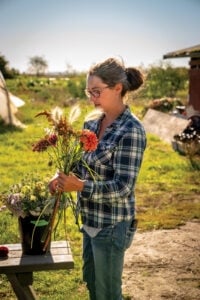 Flower arranging
Flower arranging
From ikebana, the centuries-old Japanese tradition of flower arrangement, to spontaneous wildflower gathering, styles of floral design vary widely. Organic flower farmer Rachel Ryall draws on her fine arts background when working with cut flowers. For her, the medium offers the possibility of artistically combining colours, shapes, and textures in ways we wouldn’t find in nature.
To create a stunning mixed bouquet, Ryall suggests including the following elements, in quantities that correspond to the “Rule of 3,” for visual balance.
| focal flowers | usually larger varieties, such as dahlias, peonies, or poppies |
| secondary “disc” flowers | varieties with tiny central flowers surrounded by flat “rays”: zinnia, rudbeckia, cosmo |
| filler flowers | clusters of smaller blooms, such as feverfew or statice |
| “spikes” | tall stems with flowers that bloom up: delphinium, foxglove, or snapdragon |
| interest flowers | anything that provides an unusual texture or shape, such as nigella, scabiosa, or grasses |
| greenery | possibilities include eucalyptus, mint, ferns, or hibiscus foliage |
Flower power
Researchers in a variety of fields have studied the effects of flowers on our well-being, and the results come as no surprise: flowers are good for us!
- According to a 2005 study, flowers have both immediate and long-term positive effects on our mood, our social interactions, and even our memory.
- In a 2008 study, plants and flowers in hospital rooms helped decrease pain and anxiety and generate more positive feelings during patient recovery.
- Flowers in the workplace contributed to physical and psychological relaxation in a 2014 study.
What accounts for these benefits? Experts aren’t entirely sure how our relationship with flowers works—but perhaps that mystery is part of the power.
Fashion-forward flowers
Selling to florists and wedding planners means keeping up with colour trends. Since seeding plans are made in winter, flower farmers need to make predictions about what will be popular and plant accordingly.
Finding organic flowers: some helpful resources
- Stems Flower Farm in southern Ontario (stemsflowerfarm.ca) offers a list of sustainable flower farms in Canada. Contact farms to find out where their flowers are sold.
- Canadian Flowers Week is a late-summer, cross-Canada celebration of “homegrown floral bounty.” Visit the Canadian Flowers Week website (canadianflowersweek.ca) for information, including an interactive map featuring Canadian flower farms and florists committed to providing locally grown flowers.
- The Slow Flowers Movement promotes local, seasonal, sustainably farmed flowers. Its website (slowflowers.com) offers a directory of American and Canadian flower businesses, as well as general information and event listings.



